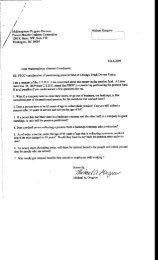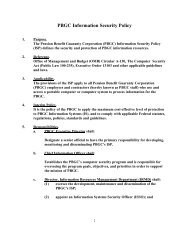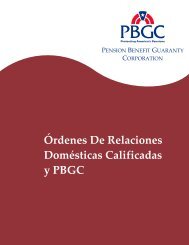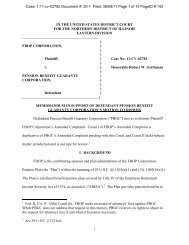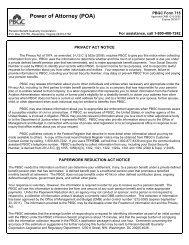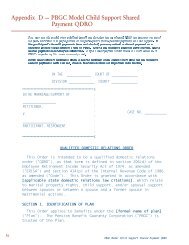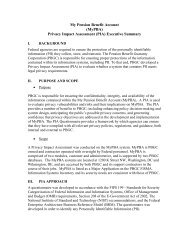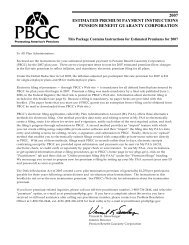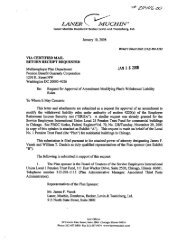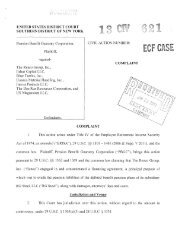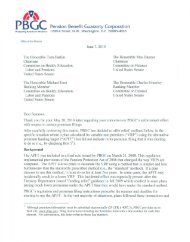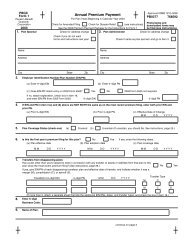Reportable Events and Certain Other Notification Requirements
Reportable Events and Certain Other Notification Requirements
Reportable Events and Certain Other Notification Requirements
Create successful ePaper yourself
Turn your PDF publications into a flip-book with our unique Google optimized e-Paper software.
PUBLIC SUBMISSION<br />
As of: May 01, 2013<br />
Received: April 03, 2013<br />
Status: Posted<br />
Posted: May 01, 2013<br />
Tracking No. 1jx-84kk-lgxa<br />
Comments Due: June 03, 2013<br />
Submission Type: Web<br />
Docket: PBGC-2013-0001<br />
<strong>Reportable</strong> <strong>Events</strong> <strong>and</strong> <strong>Certain</strong> <strong>Other</strong> <strong>Notification</strong> <strong>Requirements</strong><br />
Comment On: PBGC-2013-0001-0001<br />
<strong>Reportable</strong> <strong>Events</strong> <strong>and</strong> <strong>Certain</strong> <strong>Other</strong> <strong>Notification</strong> <strong>Requirements</strong><br />
Document: PBGC-2013-0001-0002<br />
Comment on FR Doc # 2013-07664<br />
Submitter Information<br />
Name: BRIAN P. WARNOCK<br />
Address:<br />
AMERICAN PENSION CORPORATION<br />
1375 PLAINFIELD AVE.<br />
WATCHUNG, NJ, 07069<br />
Email: APC401K@AOL.COM<br />
Phone: 908-757-5151 EX 104<br />
Fax: 908-757-9644<br />
Organization: AMERICAN PENSION CORPORATION<br />
Government Agency Type: Federal<br />
Government Agency: PBGC<br />
General Comment<br />
Get rid of the rule that makes you notify the PBGC every time a required quarterly contribution<br />
is not made. Many employers contribute annually for cash flow or convenience, <strong>and</strong> missing a<br />
quarterly contribution does not mean they will not make the required annual contribution.
file:///C:/Users/lrxxa14/Downloads/PBGC-2013-0001-0003.html<br />
Page 1 of 1<br />
05/20/2013<br />
PUBLIC SUBMISSION<br />
As of: May 20, 2013<br />
Received: May 15, 2013<br />
Status: Posted<br />
Posted: May 20, 2013<br />
Tracking No. 1jx-85cp-2nla<br />
Comments Due: June 03, 2013<br />
Submission Type: Web<br />
Docket: PBGC-2013-0001<br />
<strong>Reportable</strong> <strong>Events</strong> <strong>and</strong> <strong>Certain</strong> <strong>Other</strong> <strong>Notification</strong> <strong>Requirements</strong><br />
Comment On: PBGC-2013-0001-0001<br />
<strong>Reportable</strong> <strong>Events</strong> <strong>and</strong> <strong>Certain</strong> <strong>Other</strong> <strong>Notification</strong> <strong>Requirements</strong><br />
Document: PBGC-2013-0001-0003<br />
Comment on FR Doc # 2013-07664<br />
Name: Mark Sokolow<br />
Address:<br />
338 Wedgerock Drive<br />
Webster, TX, 77598<br />
Email: mark@mtsokolow-attorney.com<br />
Submitter's Representative: Mark Sokolow<br />
Organization: Law Office of Mark Sokolow<br />
Submitter Information<br />
General Comment<br />
COMMENTS ON PROPOSED RULES, REGULATIONS OR AGENCY ACTIONS:<br />
I would suggest that you promote electronic filing of reports.<br />
MARK SOKOLOW<br />
ATTORNEY AT LAW<br />
338 Wedgerock<br />
Webster, Texas 77598<br />
http://mtsokolow-attorney.com<br />
mark@mtsokolow-attorney.com
One Stamford Plaza<br />
263 Tresser Boulevard<br />
Stamford, CT 06901-3226<br />
T +203 326 5400<br />
towerswatson.com<br />
May 24, 2013<br />
Regulatory Affairs Group<br />
Office of the General Counsel<br />
Pension Benefit Guaranty Corporation<br />
1200 K Street NW<br />
Washington, DC 20005-4026<br />
RIN 1212-AB06<br />
RE: Proposed Regulations on <strong>Reportable</strong> <strong>Events</strong><br />
Dear Sirs <strong>and</strong> Mesdames:<br />
This letter is the response of Towers Watson to the request for public comments on the proposed<br />
modifications to regulations under ERISA Part 4043 regarding reportable events <strong>and</strong> certain other<br />
notification requirements.<br />
Towers Watson is a leading global professional services company that helps organizations improve<br />
performance through effective people, risk <strong>and</strong> financial management. Towers Watson offers solutions<br />
in the areas of employee benefits, talent management, rewards, <strong>and</strong> risk <strong>and</strong> capital management.<br />
Towers Watson employs approximately 14,000 associates on a worldwide basis. Our more than 600<br />
Enrolled Actuaries under ERISA provide actuarial <strong>and</strong> consulting services to more than 1,700 defined<br />
benefit plans in the U.S. We appreciate this opportunity to comment. The undersigned have prepared<br />
our firm’s response with input from others in the firm.<br />
Towers Watson strongly agrees with the PBGC’s decision to revise the proposal issued in 2009 with the<br />
intention of focusing reporting on those situations that present substantial risk to the PBGC. We<br />
appreciate PBGC’s thoughtful consideration of the balance between the need for information <strong>and</strong> the<br />
cost to plan sponsors (<strong>and</strong> PBGC) of reporting it, <strong>and</strong> will discuss below certain changes to the proposal<br />
that we believe would help further achieve this balance. We also support PBGC’s efforts to st<strong>and</strong>ardize<br />
<strong>and</strong> streamline the reporting process, through forms, e-filing <strong>and</strong> commonality of waivers across multiple<br />
events.<br />
Financially Sound Sponsor or Controlled Group Member<br />
The most substantial step the proposal takes in attempting to target reporting requirements at those<br />
situations that PBGC believes present risk is to provide waivers for certain post-event reporting in<br />
situations where the plan sponsor or highest US controlled group parent are viewed as “financially<br />
sound”. Financial soundness is determined according to criteria specified in the proposal <strong>and</strong> PBGC<br />
has requested comments on many aspects of this determination.<br />
We strongly support the idea of providing broad waivers in situations where there is no significant risk to<br />
PBGC. While we believe that the financial soundness criteria in the proposal represent a reasonable<br />
attempt to accomplish this over a spectrum of plan sponsors, we are concerned that the waiver will be<br />
unavailable in many situations that do not pose risk to PBGC. This result will unnecessarily use<br />
resources of plan sponsors <strong>and</strong> PBGC alike <strong>and</strong> thus should be avoided.<br />
Towers Watson Pennsylvania<br />
Page 1
May 24, 2013<br />
While we do not profess to be experts in using financial metrics to evaluate company financial<br />
soundness, our experience working with companies does allow us to provide some examples that<br />
illustrate the concern we have expressed. While each of the individual criteria seems reasonable, the<br />
requirement that all five be met would seem to withhold waivers in many situations that present little risk<br />
to PBGC. As one example, consider the requirement to have positive earnings under GAAP or IFRS for<br />
the past two years. In our experience, it is not at all uncommon for stable, profitable companies to show<br />
accounting losses from time to time for any number of reasons, such as restructurings, normal business<br />
cycles <strong>and</strong> extraordinary events.<br />
As another example, consider the requirement that the entity have no secured debt, disregarding leases<br />
or debt incurred to acquire or improve property <strong>and</strong> secured only by that property. Companies that have<br />
unsecured debt available to them will still often provide security as a means of obtaining a lower interest<br />
rate. Furthermore, a company may take on the secured debt of an entity it acquires <strong>and</strong> either carry it<br />
or unwind it over time. That secured debt would not be indicative of the acquiring company’s financial<br />
soundness.<br />
We believe that adding additional criteria based on items such as free cash flow, earnings from<br />
continuing operations, net worth <strong>and</strong> commonly used financial ratios, <strong>and</strong> requiring companies to meet<br />
only a certain number of them (for example, 75%), would better target situations that present real risk<br />
<strong>and</strong> thus achieve a better balance between the need for information <strong>and</strong> the cost of reporting. If PBGC<br />
believes that certain criteria are critical, PBGC could require those criteria plus a percentage (e.g., 50%)<br />
of the remaining criteria be satisfied.<br />
With respect to the requirement regarding missed contributions, we recommend that an exception be<br />
granted for missed contributions caused solely by the failure to make a timely funding balance election.<br />
In such situations there is no requirement that cash be contributed to the plan, as the money is already<br />
in the plan. As with missed contributions corrected within 30 days, this “contribution” is missed solely<br />
due to administrative oversight. Such situations in no way indicate risk to PBGC.<br />
We note that in certain situations, it may not be possible to determine if the financial soundness criteria<br />
is met when an event occurs. For example, net income for the prior fiscal year may not be known by<br />
the reporting date for an event that occurs early in the fiscal year. There may be other such timing<br />
issues, such as whether an entity is required to file a US tax return for a fiscal year. In such situations<br />
we would suggest that the second <strong>and</strong> third prior years be used.<br />
Plan Financial Soundness<br />
We underst<strong>and</strong> PBGC’s experience in taking over plans that were more than 80% funded on a variable<br />
premium basis has caused it to propose stricter plan funding based thresholds for reporting waivers.<br />
However, we believe that PBGC has increased the threshold far too much <strong>and</strong> set it at a level that 1)<br />
virtually no plans would currently meet, <strong>and</strong> 2) provides for NO risk to PBGC as opposed to risk that is<br />
not substantial enough to require reporting.<br />
We believe that 90% of plan termination liabilities is a more appropriate level at which to provide<br />
reporting waivers. We maintain that withholding waivers from plans that are close to 100% funded on<br />
a termination basis would essentially assume that all of these plans are at risk of termination any time a<br />
reportable event occurs, <strong>and</strong> does not strike the right balance between PBGC’s need for information<br />
<strong>and</strong> the burden on plan sponsors. The reports would also tax the resources of PBGC <strong>and</strong> prevent it<br />
from adequately focusing on the small subset of these situations where a termination that would impose<br />
substantial liability on PBGC seems possible. Lastly, we note that a plan termination measurement does<br />
not exist for most plans so that this criterion has little practical application.<br />
Page 2
May 24, 2013<br />
We also believe that the variable premium rules already contain a risk-based element <strong>and</strong> that the<br />
waivers should reflect that element. Specifically, if a plan is funded well enough so that it is not required<br />
to pay variable rate premiums, it should be granted a waiver from reporting. If a plan is viewed as not<br />
presenting enough risk to PBGC to pay risk-based premiums then it seems clear that the level of risk<br />
presented by the plan is small <strong>and</strong> thus waivers from post-event reporting are appropriate. This is<br />
essentially the same as reducing the proposed 120% threshold to 100%, which is the maximum level at<br />
which we believe it should be set<br />
Combined Financial Soundness<br />
As noted previously, we believe that the proposal will require reporting in many situations that do not<br />
pose a substantial risk to the PBGC. One reason for this is the separation of the financial soundness<br />
waivers for the sponsor <strong>and</strong> the plan. We underst<strong>and</strong> that keeping these waivers separate can be<br />
viewed as reducing the complexity of the waiver provisions, especially when compared to the current<br />
rules. However, there will be many circumstances where both the sponsor <strong>and</strong> the plan come close to,<br />
but do not meet, the financial soundness criteria. Such situations would likely not present substantial<br />
risk to PBGC, <strong>and</strong> we recommend that some kind of combination waiver be available. For example,<br />
assuming our suggestions above are adopted <strong>and</strong> the sponsor requirement is 75% of revised criteria<br />
<strong>and</strong> the plan requirement is 90%/100% funded on a termination/ongoing basis, the regulation might<br />
provide that situations in which the company meets 65% of the requirements AND the plan is 80%/90%<br />
funded would qualify for a waiver.<br />
Another alternative for combined waivers would be to compare measures of the plan to that of the plan<br />
sponsor or controlled group. For example, if plan underfunding is only a very small percentage of free<br />
cash flow or operating income or net worth, then there would seem to be little risk to PBGC.<br />
Conclusion<br />
We thank you for the opportunity to comment on the proposed regulations. We applaud the goals of the<br />
proposals – to make the process more efficient <strong>and</strong> to require reporting only in those situations that<br />
genuinely present risk to PBGC. We believe that the proposal can be improved to better accomplish<br />
these goals <strong>and</strong> have made suggestions to that effect. We would welcome the opportunity to discuss<br />
these comments at your convenience.<br />
Michael F. Pollack, FSA, EA<br />
Senior Consultant, North America Retirement Actuarial Leadership<br />
mike.pollack@towerswatson.com<br />
(203) 326-5469<br />
Maria M. Sarli, FSA, EA<br />
U.S. Retirement Resource Actuary<br />
maria.sarli@towerswatson.com<br />
(404) 365-1708<br />
Page 3



